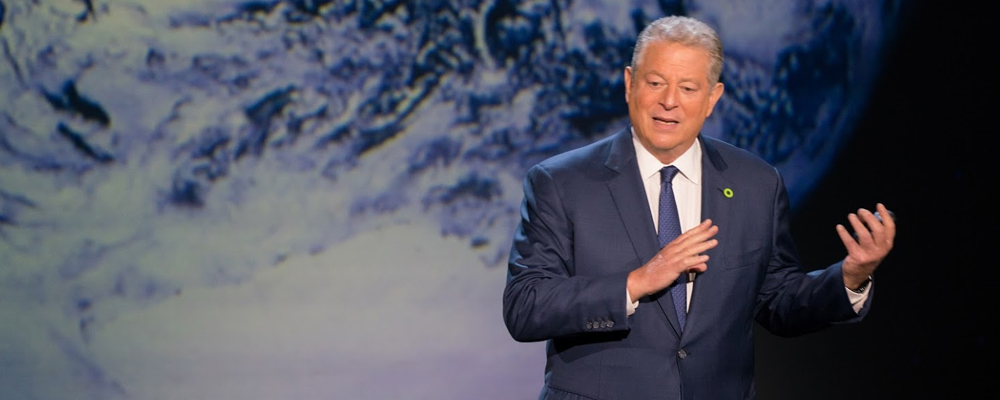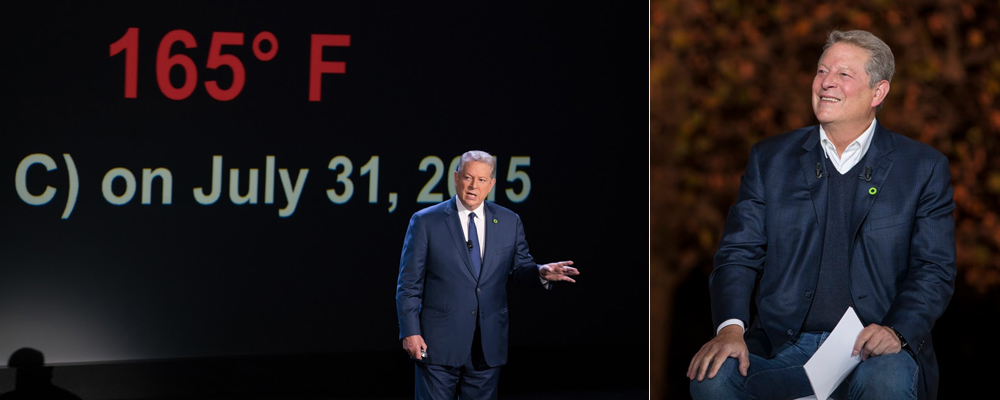Dystopian Horrors Are a Thing of the Present in ‘An Inconvenient Sequel: Truth To Power’
Tony Sokol
A decade ago, Al Gore premiered his film debut, “An Inconvenient Truth.” It was seven years after the former vice president lost the race to the White House in a squeaker election against George W. Bush. Their approaches to governing couldn’t have been more different. Gore had an inconveniently excessive number of popular votes over the incoming president, but politely stepped aside for the sake of the country. He reemerged with a full beard and one of the most influential films of the past generation. Directed by Davis Guggenheim, the film inspired documentary filmmakers, but more importantly, it brought the subject of climate change to the forefront of international dialogue. The follow-up, “An Inconvenient Sequel: Truth to Power,” aims to continue the conversation before current governments change the topic.
Whispers of climate change turned to screams since the first film screened, and Donald Trump’s win over Hillary Clinton threaten to turn those yells into whimpers. Directed by Bonni Cohen and Jon Shenk, “An Inconvenient Sequel” follows Gore around as he keeps those voices alive. It might seem disingenuous to reference speaking truth to power when Al Gore sat in the second most powerful chair on the planet, but he does speak for the underdog: scientific knowledge. Gore has been speaking about climate change for 25 years, and shows no sign of tiring.
But the film shows there are a lot of people who are tired of Al Gore. The first sounds we hear, after a long shot of the Greenland ice caps dripping away the future, are people telling him to shut up. Congress tells him to shut up. Presidential nominee Donald J. Trump tells him to shut up. One of the scientists showing Gore the disappearing polar cap muffles a muted scoff at one of the ex-vice president’s jokes. His message is clear, but it is as inconvenient as the crisis in the title.
Gore isn’t the most charismatic guy on the planet, even when he’s yelling. But you can’t deny his passion and his commitment. Al Gore says he’s a “recovered politician,” that one more election will knock him off the wagon. But as he treks across America, Greenland, India, Europe, Asia and the Paris climate negotiations, we see a consummate politician who is the son of a politician. He sits across the table from a delegation from India who only want the same period of energy growth and abundance the United States saw for 150 years under the fossil fuel industry. Gore checks a few technical pages, makes a few calls, and gets a charitable gift of a field of solar panels. India signs the accord.
The 2015 global conference on climate change is interrupted by the coordinated Friday the 13th of November terrorist attacks on Paris and the suburb Saint-Denis. The carnage, and its inconvenient timing, almost drives Gore to despair, but the talks go on, reconvened a few weeks later. We get a glimmer of hope from archival footage of President Barack Obama pledging his support along with the leadership of Russia, China, Germany, and most world governments. This balm is broken when we read about Trump pulling out of the agreement early in his term.
The settings are impressive and vast. The film is set on the earth, from small town Republican headquarters to Trump Towers, through farms, deserts, oceans and a view from the sun. Funded during the Clinton administration, Nasa’s Discovery satellite was first stripped of all useful environmental measuring equipment until it could only predict solar flares. It was relaunched under Obama to provide the most damning cinematography of the documentary.
“An Inconvenient Sequel” is not without cinematic suspense. Besides the impending doom of the entire planet, the filmmakers show devastation of the present. Close-up, personal documentation of flood rescues play against the wall of water the typhoon threw on Tacloban, Philippines. If the temperature of the water was only a few degrees cooler, that wall would have never been built. Arid shots of worldwide droughts from the loss of moisture from heated ground soil compete against a third world urban sprawl that looks like the beginning of a “Mad Max” movie. This is some scary shit. This is “Dystopia Now!”
“An Inconvenient Sequel” is an effective piece of important science-based propaganda that preaches to the choir. Documentary watchers are already sympathetic to rising tides, flooding, and the sad, sad shots of an increasingly suffocating earth from outer space. We’re already scared. Seeing the groaning ice boulders cracking and bleeding into the ocean is painful. Watching the mechanism of government is torture. The film ends on a note of grand hopes that come from unlikely places. Solar energy is growing in South America, and India took out the largest loan in history to fund its energy alternatives. The greatest hope comes from the grassroots groups promising to spread the word.
“An Inconvenient Sequel: Truth to Power” opens in theaters July 28.





